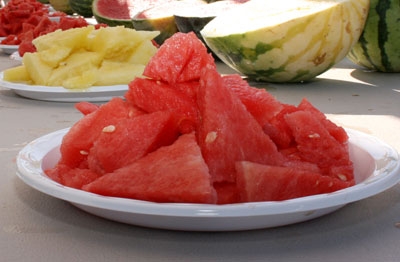Posts Tagged: Cathi Lamp
Eating right doesn’t have to break the budget
Even though dietitians have for decades strongly recommended eating lots of fruit and vegetables daily, very few Americans hit the mark. Food prices, taste, inconvenience, and a failure to understand the link between diet and health have been blamed for Americans’ poor food choices.
New research by the USDA Economic Research Service dispels one of those obstacles. The study determined that buying the recommended amount of fruits and vegetables costs on average only $2 to $2.50 per day.
“For those with access and the means to buy them, the assertion that fruits and vegetables are too expensive is not a good excuse,” said UC Cooperative Extension nutrition, family and consumer sciences advisor Cathi Lamp. “Consumers should be able to purchase a days’ worth of fruit and vegetables for less than it costs to buy a cheeseburger.”
The ERA researchers estimated the average retail prices of 153 fresh and processed fruits and vegetables. Processed fruits and vegetables included frozen, canned and dried plus 100 percent fruit juice. They also estimated the average price per edible cup for each vegetable and fruit.
Costs in the study were defined as the average prices paid by all American households for a food over a one-year period, including purchases in different package sizes, under different brand names and at different types of retail outlets (including supercenters such as Wal-Mart, wholesale club stores like Costco, traditional grocery stores such as Safeway, Kroger and Albertsons, and convenience stores.)
The research indicated that:
- Fruits and vegetables cost about 50 cents per edible cup.
- The lowest average price for any of the 59 fruits in the study was for fresh watermelon, at 17 cents per cup. The highest average price was for fresh raspberries, at $2.06 per cup.
- Among the 95 fresh and processed vegetables in the study, a cup of dry pinto beans was the least expensive at 13 cents. The most expensive was frozen asparagus cuts and tips at $2.07 per cup.
- Processed fruits and vegetables were not consistently more or less expensive than fresh produce, but with certain types of produce, the prices varied quite a bit. Canned carrots, at 34 cents per cup, were more expensive than fresh carrots, at 25 cents per cup. However, canned peaches, at 58 cents per cup, were less expensive than fresh, at 66 cents per cup.
Lamp suggested smart shopping can also help consumers reduce the cost of their fruits and vegetables. For example, buy fresh fruit and vegetables in season, use canned and frozen fruit and vegetables when it is cheaper and stock up when items are on sale or when shopping at a supercenter or wholesale club.

USDA says fresh watermelon is, on average, the least expensive fruit.
A new approach in teaching healthy eating
UC Cooperative Extension nutrition educators have discovered that, when it comes to teaching consumers how to eat right, a picture is worth of thousand words.
“We’ve been teaching people for years about MyPyramid and the dietary guidelines, serving sizes and the number of servings they should eat, but many were having a hard time translating that to what exactly to put on their plates,” said Cathi Lamp, the nutrition, family and consumer sciences advisor for Tulare County UCCE.
In an effort to simplify nutrition education, UCCE started with a graphic of a plate, with half designated for fruits and vegetables and a quarter each for protein and grains. However, the concept was still too abstract for concrete thinkers.
“Then we hit upon the idea of photographing familiar foods in the right proportions and showing actual serving sizes arranged on a plate,” Lamp said.
Lamp, and the nutrition, family and consumer sciences advisors for Fresno County, Connie Schneider, and Kern County, Margaret Johns, set out to review 24-hour recall surveys that had been conducted by participants in UCCE nutrition education classes. The 24-hour recall surveys, a mainstay in nutrition research, ask participants to write down everything they have eaten in the previous 24 hours. Each of the advisors focused on recalls from target population groups – Latinos, African-Americans and the general population.
Once they knew what foods people eat, Lamp, Schneider and Johns began the labor-intensive process of preparing and photographing test pictures showing healthy food combinations. Meals included chicken, pizza, spaghetti, sandwiches, tacos, pork chops, fish, stir fry, hamburger, soup and eggs.
Eighteen plates of food were photographed for initial, informal testing. Lamp took the photos to an education session at the local WIC office, where pregnant women and new mothers receive federal nutrition support.
“We handed out a little form and asked the moms if they could identify the foods, whether these were foods they would eat and, if not, what changes they would make,” Lamp said. “The WIC educators loved the images. They could see the value of images of healthy food right off the bat.”
The next step will be cognitive testing of the photos with target clientele, adjustment of the photos based on the results of the testing, retesting the photos in a nutrition education setting and analyzing the results.
Cathi Lamp explains food plate design process.

